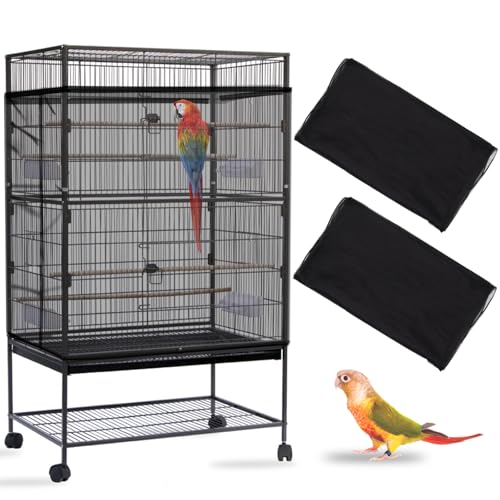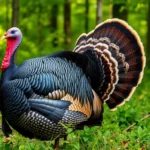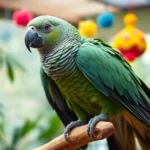Setting up the perfect bird cage isn’t just about choosing the right size—it’s about creating a thriving environment that keeps our feathered friends healthy and happy. We’ve all seen poorly designed setups that leave birds stressed or bored, but the good news is that with the right knowledge, we can transform any cage into a bird paradise.
From perch placement to food station positioning, every detail matters when we’re designing our bird’s home. The difference between a basic cage and an optimal setup can dramatically impact our pet’s physical health, mental stimulation, and overall quality of life.
Whether you’re bringing home your first bird or upgrading an existing setup, we’ll walk you through the essential elements that make all the difference. Let’s jump into the key components that’ll help you create a cage environment your bird will absolutely love.
Essential Bird Cage Setup Components
Essential components form the foundation of every successful bird cage setup, determining your feathered companion’s daily comfort and wellbeing. We focus on three critical elements that transform a basic enclosure into a thriving habitat.
Cage Size and Bar Spacing Requirements
Cage dimensions must accommodate your bird’s wingspan with room to stretch completely without touching the sides. We recommend cages measuring at least 24 inches wide, 24 inches deep, and 30 inches tall for medium-sized birds like cockatiels and conures. Large parrots such as macaws and cockatoos require cages measuring 36 inches wide, 48 inches deep, and 60 inches tall minimum.
Bar spacing prevents escapes while allowing proper ventilation and visibility. Small birds like finches and canaries thrive with bar spacing between 0.25 and 0.5 inches. Medium birds including cockatiels require spacing between 0.5 and 0.75 inches. Large parrots need spacing between 0.75 and 1 inch to prevent head entrapment.
Horizontal bars enable natural climbing behaviors that vertical bars cannot provide. We position horizontal bars on at least two sides of the cage to create climbing opportunities. Powder-coated steel or stainless steel materials resist rust and provide durability over galvanized options that can release toxic zinc.
Perches and Placement Strategy
Natural wood perches provide varying diameters that exercise foot muscles and prevent pressure sores. We select branches from apple, birch, or willow trees with diameters ranging from 0.5 inches to 2 inches for different grip positions. Sandpaper perches cause foot irritation and we avoid them completely.
Placement creates a layered environment with perches at different heights and locations. We position the highest perch 6 inches from the cage top to prevent tail damage when birds stretch upward. Lower perches sit at varying levels to create natural movement patterns between feeding and resting areas.
Distance between perches encourages flight and exercise within the confined space. We space perches 12 to 18 inches apart horizontally to allow short flights between stations. Diagonal placement creates interesting pathways that stimulate natural foraging instincts and exploration behaviors.
Food and Water Stations
Stainless steel bowls resist bacteria growth and clean easier than plastic alternatives that scratch and harbor germs. We use separate bowls for pellets, fresh foods, and water to prevent contamination and spoilage. Bowl capacity matches your bird’s daily consumption with 4-ounce bowls for small birds and 8-ounce bowls for larger species.
Station placement keeps food and water away from perches directly overhead to prevent droppings contamination. We position feeding stations on opposite sides of the cage to encourage movement and exercise during meal times. Water stations require daily cleaning and refilling with fresh water.
Multiple feeding locations reduce competition in multi-bird households and provide backup options if one station becomes soiled. We install at least two food stations and one water station for single birds. Multi-bird setups require one additional station per bird to prevent territorial disputes and ensure equal access to nutrition.
Creating a Safe and Comfortable Environment

Building upon the foundation of proper cage size and essential components, we must focus on environmental factors that directly impact our bird’s daily comfort and long-term health. These elements work together to create a habitat that supports natural behaviors while protecting our feathered companions from stress and illness.
Proper Cage Location and Lighting
Positioning your bird cage requires careful consideration of multiple factors that affect your pet’s well-being throughout each day. We recommend placing the cage against a solid wall to provide security while maintaining visibility of the room’s main activity areas. Corner placements offer additional protection but can limit social interaction opportunities that most birds crave.
Traffic patterns in your home directly influence stress levels in caged birds. High-traffic hallways and entryways create constant disturbances that can lead to chronic anxiety. Living rooms and family areas typically provide the ideal balance of social stimulation without overwhelming activity levels.
Natural lighting cycles support healthy hormonal rhythms in pet birds. Position cages near windows that receive indirect sunlight for 10-12 hours daily while avoiding direct sun exposure that can cause overheating. Artificial lighting becomes necessary during shorter winter days when natural light exposure drops below optimal levels.
Full spectrum LED bulbs designed specifically for birds provide the UV wavelengths essential for vitamin D synthesis and calcium absorption. Install these lights 12-18 inches above the cage and maintain consistent 12-hour on/off cycles to simulate natural daylight patterns.
Temperature Control and Ventilation
Temperature stability prevents respiratory issues and supports immune system function in captive birds. We maintain ambient temperatures between 65-75°F (18-24°C) for most species while avoiding sudden temperature fluctuations that can trigger stress responses.
Room drafts pose important health risks to birds whose respiratory systems are particularly sensitive to air movement. Position cages away from heating vents, air conditioning units, and frequently opened doors or windows. Even minor drafts can cause respiratory infections that progress rapidly in small birds.
Ventilation requirements balance fresh air circulation with temperature stability. Ceiling fans provide gentle air movement when operated on low settings but create dangerous drafts when positioned directly above cage locations. Opening windows in different rooms creates cross-ventilation without exposing birds to direct airflow.
Humidity levels between 50-60% support healthy respiratory function and prevent dry air from irritating sensitive nasal passages. Humidifiers help maintain consistent moisture levels during winter months when indoor heating systems reduce ambient humidity. Monitor levels with digital hygrometers to ensure optimal ranges year-round.
Cage Bottom and Bedding Options
Substrate selection directly impacts cage hygiene and your bird’s health since contaminated bedding harbors bacteria and parasites. We recommend newspaper as the most practical option because it’s inexpensive, absorbent, and easily replaceable. Black and white newsprint poses no toxicity risks when birds occasionally nibble on substrate materials.
Paper towels provide superior absorbency for birds that produce large amounts of liquid waste but require more frequent changes than newspaper. Plain white paper towels without dyes or fragrances prevent chemical exposure while maintaining easy cleanup routines.
Cage liners designed specifically for birds offer convenience with pre-cut sizing and antimicrobial treatments. These commercial options cost more than newspaper but provide added protection against bacterial growth during extended periods between cleanings.
Avoid cedar shavings, pine shavings, and scented substrates that release aromatic oils harmful to bird respiratory systems. Corn cob bedding and walnut shell substrates create ingestion hazards when curious birds consume inedible materials. Sand and gravel substrates cause impaction issues if consumed in important quantities.
Substrate depth affects both hygiene and bird behavior patterns. Maintain 1/4 to 1/2 inch of bedding to absorb waste without creating spaces for bacteria accumulation. Replace bedding materials every 2-3 days or immediately when contamination occurs to prevent health complications.
Enrichment and Entertainment Features
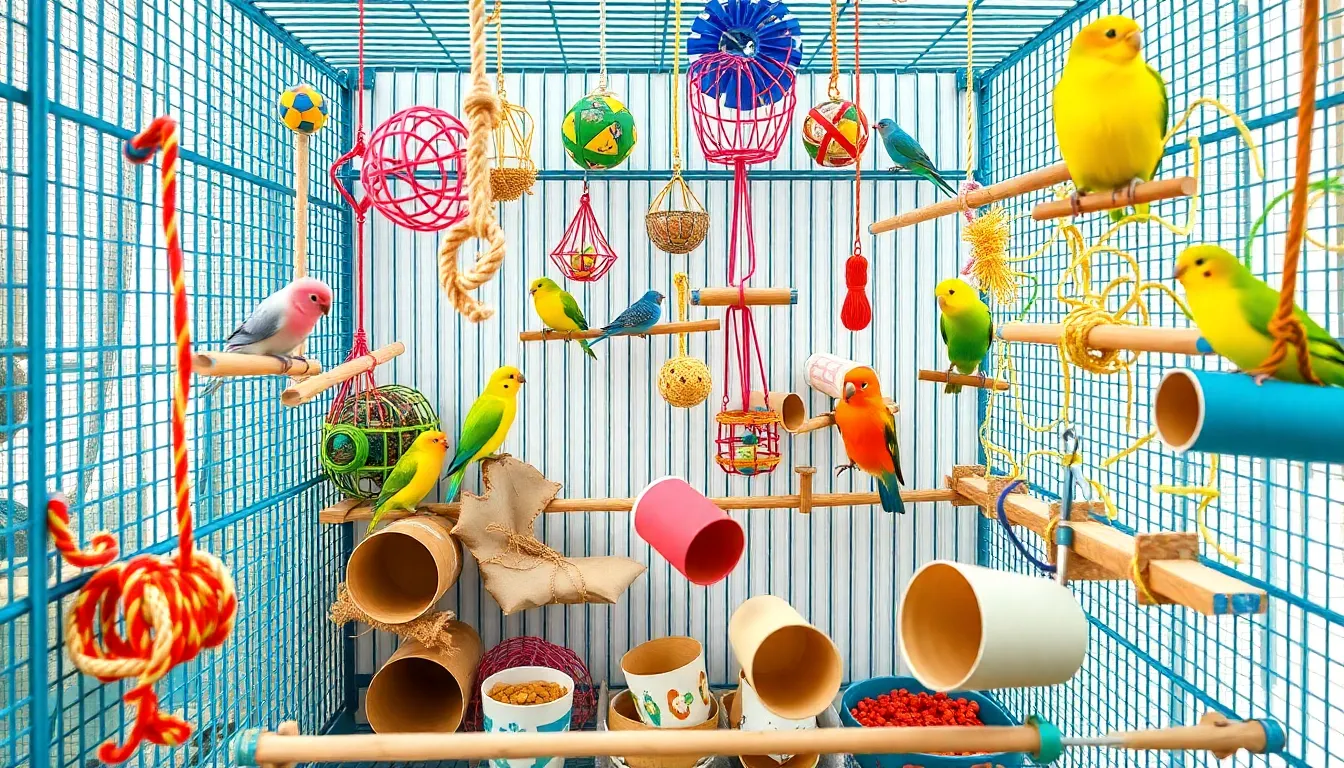
Bird cage setup extends beyond basic necessities to include mental stimulation and physical activity elements. We transform cages from simple housing into captivating environments that promote natural behaviors and prevent boredom through strategic enrichment placement.
Toys and Rotation Schedule
Rotating toys every 7 to 10 days maintains your bird’s interest and prevents habituation to static objects. We recommend maintaining 3 to 4 toys per cage simultaneously while storing additional items for future rotation cycles.
Essential toy categories include:
- Puzzle toys that challenge problem solving abilities
- Shredding materials like paper strips and palm leaves
- Swinging perches that encourage balance and movement
- Foraging balls filled with treats or food portions
Different bird species require exact toy types and sizes to match their natural behaviors and beak strength. Cockatoos benefit from destructible wooden blocks while finches prefer small hanging mirrors and bells. We inspect all toys weekly for wear damage and sharp edges that could cause injury.
Foraging Opportunities
Natural foraging behaviors occupy 60% to 80% of wild birds’ daily time and we replicate this instinct through strategic food hiding techniques. Hide portions of your bird’s daily food allocation in paper cups, cardboard tubes, and specialized foraging containers throughout the cage space.
Effective foraging setups incorporate:
- Paper towel rolls stuffed with pellets and dried fruits
- Cardboard egg cartons containing scattered seeds
- Hanging treat dispensers that release food through manipulation
- Shallow boxes filled with shredded paper hiding nutritious rewards
Introduce foraging gradually over 2 to 3 weeks to allow birds time to develop searching skills. Start with partially visible food items before progressing to completely hidden treats that require more complex problem solving.
Exercise and Play Areas
Designated exercise zones within the cage promote physical fitness and reduce stress related behaviors like excessive preening or screaming. We create activity areas using varying perch heights and strategic toy placement that encourages climbing and wing stretching.
Key exercise elements feature:
- Rope perches positioned at different cage levels
- Climbing nets attached to cage walls
- Swing sets placed away from food and water stations
- Open flight paths measuring at least 18 inches horizontally
Large birds require supervised out of cage time for 2 to 4 hours daily to maintain proper muscle tone and cardiovascular health. Smaller species like budgerigars and cockatiels benefit from in cage obstacle courses using branches and platforms at multiple elevations.
Health and Hygiene Considerations
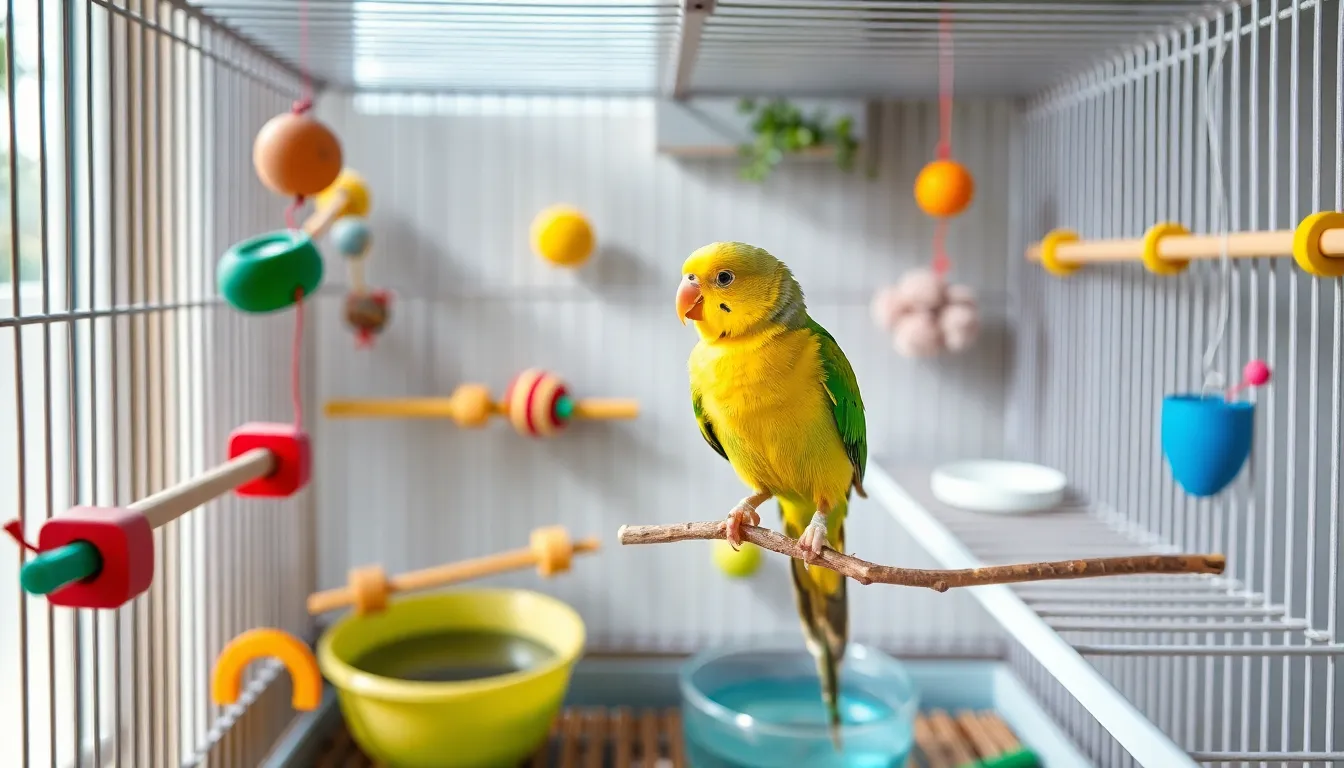
Maintaining a clean cage environment directly impacts your bird’s respiratory health and prevents the spread of harmful bacteria. Regular cleaning protocols combined with health monitoring create the foundation for your bird’s long-term wellbeing.
Daily Cleaning Routines
We recommend establishing consistent daily cleaning habits to prevent waste accumulation and bacterial growth. Remove uneaten fresh foods within 2-4 hours to avoid spoilage and contamination. Change water daily using fresh, clean sources and wash bowls with hot soapy water before refilling.
Spot clean perches and cage bars where droppings accumulate using bird-safe disinfectants or vinegar answers. Replace cage bottom papers or substrates each day to maintain dry conditions and reduce odor. Wipe down food bowls after each feeding to prevent sticky residue buildup that attracts insects and bacteria.
Weekly Deep Cleaning Methods
Deep cleaning routines eliminate embedded dirt and sanitize cage components that daily maintenance can’t address. Disassemble removable parts like perches, toys, and feeding stations for thorough washing with hot water and bird-safe soap. Scrub cage bars using a stiff brush to remove accumulated grime and dried droppings.
Soak heavily soiled items in a 10% bleach solution for 10 minutes, then rinse thoroughly and air dry completely before reinstalling. Clean cage trays and grates in the bathtub or outside using a hose for easier debris removal. Replace worn perches and damaged toys that can’t be adequately sanitized during your weekly routine.
Monitoring Your Bird’s Health
Visual health assessments during cage maintenance provide early detection of potential problems. Watch for changes in droppings consistency, color, or frequency as these indicate digestive or stress issues. Monitor eating and drinking patterns by checking food and water levels at consistent times throughout the day.
Observe your bird’s posture, activity level, and breathing patterns while performing cleaning tasks. Healthy birds maintain upright postures, show consistent energy levels, and breathe without visible effort or tail bobbing. Document any behavioral changes like excessive sleeping, reduced vocalization, or loss of appetite in a health journal for veterinary reference.
Check for physical signs of illness including discharge from eyes or nostrils, feather plucking, or unusual swelling around the face or feet. Schedule veterinary checkups every 12 months for healthy adult birds and every 6 months for senior birds over 10 years old.
Common Bird Cage Setup Mistakes to Avoid
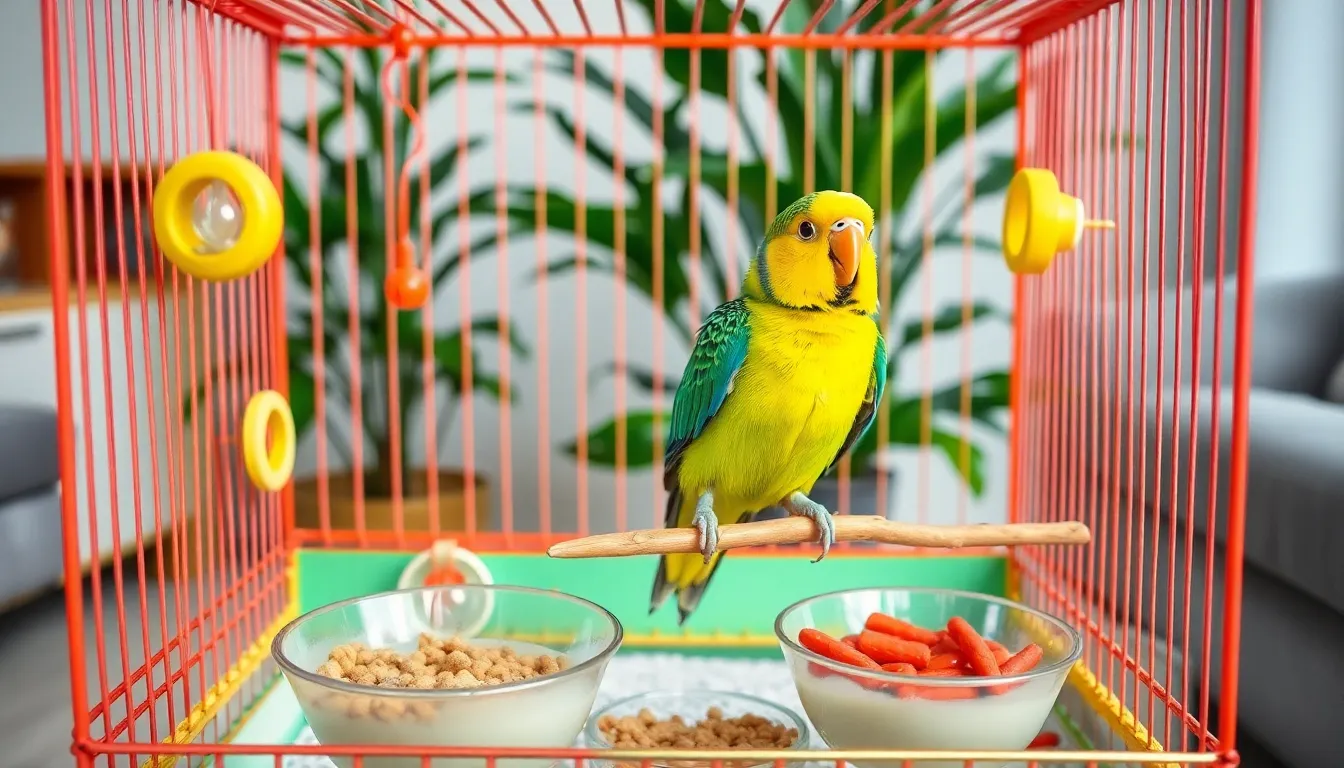
Even experienced bird owners can fall into setup traps that compromise their pets’ wellbeing. Recognizing these frequent errors helps us create safer and more comfortable environments for our feathered companions.
Overcrowding and Poor Layout
Cramming too many accessories into a cage creates navigation obstacles and stress for birds. We observe that owners often place perches too close together, forcing birds to squeeze between barriers instead of flying naturally. Strategic spacing between elements allows birds to spread their wings fully and move without obstruction.
Positioning toys and feeding stations in flight paths blocks essential exercise space. Birds require clear horizontal routes spanning at least 18 inches for short flights within their cage. We recommend designating exact zones for different activities rather than scattering items randomly throughout the space.
Multiple birds housed in undersized cages develop territorial behaviors and aggression. Each additional bird requires 25% more cage volume beyond the base requirements for a single occupant. Competition for resources increases when birds cannot establish separate territories within their shared environment.
Food bowls placed directly beneath perches collect droppings and create contamination hazards. We position feeding stations at cage ends or corners away from roosting areas. Water sources located near toys or swings become playgrounds rather than drinking stations, leading to constant refills and potential dehydration.
Unsafe Materials and Toxic Items
Zinc-coated and galvanized cages release harmful metals that cause poisoning in birds over time. We identify safe materials through manufacturer specifications and avoid any cage containing lead, zinc, or copper components. Stainless steel and powder-coated options provide durability without toxic risks.
Wooden perches treated with chemicals or stains introduce respiratory irritants and digestive toxins. Natural hardwood branches from apple, willow, or birch trees offer safe alternatives when properly cleaned and prepared. We avoid cedar and pressure-treated lumber that contains harmful preservatives.
Certain toys and accessories contain dangerous elements like small metal chains, painted surfaces, or synthetic materials. Fabric toys with loose threads create entanglement hazards, while mirrors can trigger obsessive behaviors in some species. We select bird-exact products tested for safety and durability.
Household items repurposed as cage accessories often contain hidden dangers. Plastic containers may contain BPA or other chemicals, while costume jewelry includes toxic metals and small parts. Kitchen utensils and create supplies frequently have sharp edges or toxic coatings unsuitable for bird environments.
Inadequate Maintenance Practices
Delayed waste removal allows bacteria and mold to flourish in cage environments. We empty food bowls within 4 hours of serving fresh foods and change water daily to prevent contamination. Droppings left on perches and cage bars create unsanitary conditions that promote respiratory infections.
Using harsh cleaning chemicals or bleach products damages bird respiratory systems and leaves toxic residues. Vinegar and water answers effectively sanitize surfaces without introducing harmful fumes. We rinse all cleaned components thoroughly and allow complete air drying before returning birds to their cage.
Irregular deep cleaning schedules permit grime buildup that harbors pathogens and parasites. Weekly disassembly and thorough washing of all cage components maintains hygienic conditions essential for bird health. Spot cleaning between deep cleans addresses immediate contamination without disrupting established routines.
Ignoring signs of wear on cage accessories creates safety hazards and health risks. Frayed rope perches develop loose fibers that tangle around bird feet, while cracked food bowls harbor bacteria in crevices. We inspect all cage elements monthly and replace damaged items immediately to prevent accidents and illness.
Species-Specific Setup Requirements
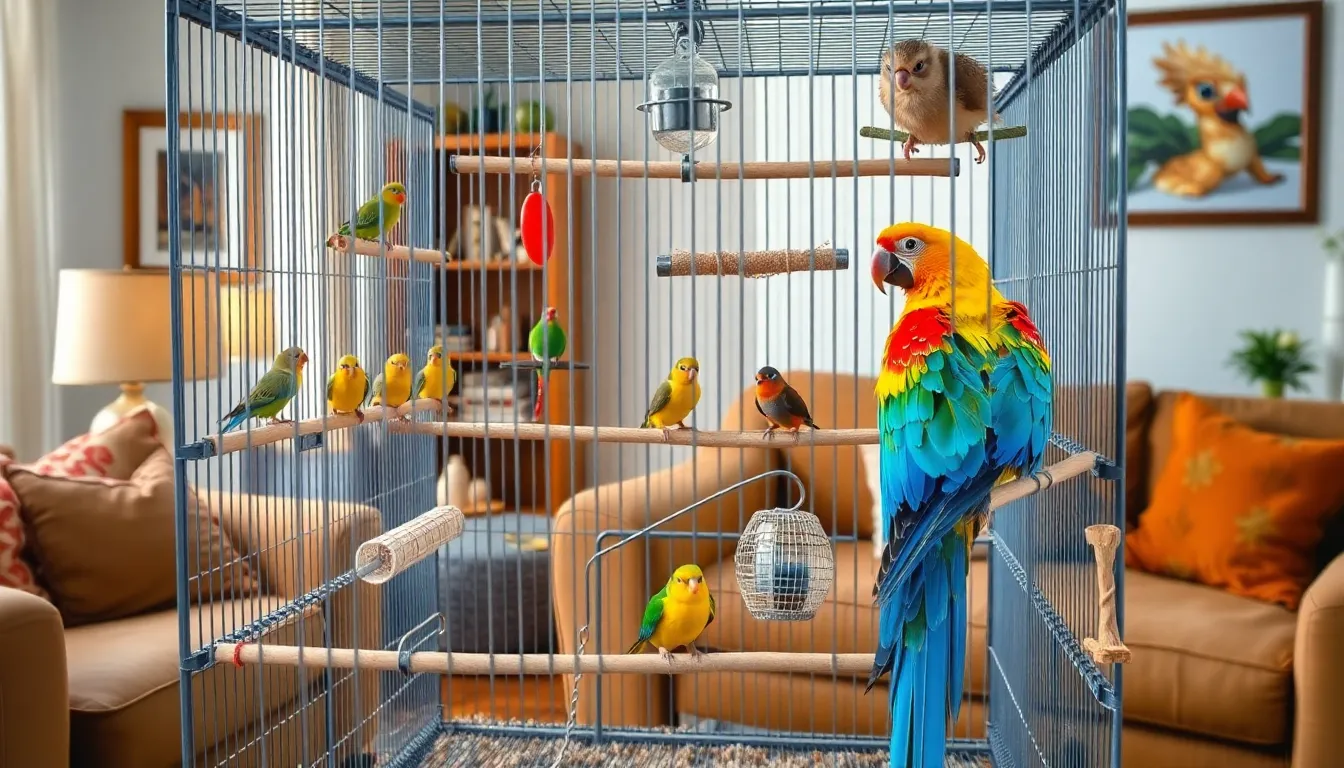
Different bird species have unique habitat needs that directly impact their physical health and behavioral development. Tailoring cage environments to match exact requirements prevents stress related disorders and promotes natural behaviors.
Small Birds vs Large Birds
Small finches and canaries thrive in horizontal cages measuring 30 inches wide by 18 inches deep, allowing for lateral flight patterns that mirror their natural movement. These compact species benefit from bar spacing between 1/4 to 1/2 inch to prevent escapes while maintaining proper ventilation.
Large parrots like macaws and cockatoos require vertical space reaching 6 feet in height with bar spacing of 3/4 to 1 inch for safety and comfort. Cockatoos specifically benefit from reinforced stainless steel construction due to their powerful beaks and destructive tendencies.
Medium sized birds including conures and cockatiels perform best in cages measuring 36 inches wide by 24 inches deep by 48 inches tall. Amazon parrots demonstrate increased activity levels when provided with multiple perch levels spanning different cage zones.
Food station placement varies significantly between species sizes, with small birds requiring elevated feeding areas 12 inches from cage bottom to prevent ground contamination. Large birds access food more naturally when stations position 18 to 24 inches above the cage floor, mimicking tree canopy feeding behaviors.
Toy selection differs dramatically across size categories, with finches captivating most effectively with small mirrors and bells measuring under 2 inches. Macaws require substantial puzzle toys and foraging devices measuring 6 to 8 inches to satisfy their cognitive needs and prevent boredom behaviors.
Single Bird vs Multiple Birds
Single birds benefit from increased human interaction zones positioned near family activity areas to prevent isolation stress. Solitary cockatiels show improved vocalization patterns when cages face main living spaces with clear sightlines to daily household routines.
Multiple bird environments require territorial spacing with minimum distances of 24 inches between individual feeding stations. Aggressive species like lovebirds need visual barriers using natural wood dividers to reduce confrontational behaviors during feeding times.
Flight path planning becomes critical in multi bird setups, with perch arrangements creating separate flight corridors for each inhabitant. Dominant birds typically claim upper cage territories, making lower perch placement essential for submissive cage mates.
Food competition management involves providing duplicate feeding stations positioned at opposite cage ends to ensure equal access. Water sources multiply to match bird quantities, with recommendations for 2 water stations per bird to prevent guarding behaviors.
Social species including budgerigars demonstrate reduced stress indicators when housed in pairs or small groups of 3 to 4 individuals. Territorial birds like many cockatoo species perform better in individual housing arrangements that eliminate competition stress entirely.
Enrichment distribution requires strategic placement to prevent resource monopolization, with rotating toy schedules ensuring each bird receives adequate mental stimulation. Foraging opportunities scatter throughout cage zones to accommodate multiple birds simultaneously without creating conflict situations.
Conclusion
Creating the perfect bird cage setup requires careful attention to detail and a deep understanding of your feathered friend’s exact needs. We’ve covered everything from essential cage components and safety considerations to species-exact requirements and enrichment strategies that’ll keep your bird happy and healthy.
Remember that a well-designed cage isn’t just a place for your bird to live—it’s their entire industry. By implementing proper perch placement food station positioning and regular cleaning routines you’re investing in your pet’s long-term wellbeing and quality of life.
The effort you put into perfecting your bird cage setup today will pay dividends in the form of a more active engaged and content companion for years to come.
Frequently Asked Questions
What is the most important factor when setting up a bird cage?
The most important factor is creating a thriving environment that goes beyond just size. This includes proper cage dimensions, appropriate bar spacing, strategic perch placement, and optimal food station positioning. The goal is to ensure your bird’s physical health, mental stimulation, and overall quality of life through thoughtful cage design.
How often should I rotate my bird’s toys?
You should rotate your bird’s toys every 7 to 10 days to maintain interest and prevent habituation. Use a mix of puzzle toys, shredding materials, swinging perches, and foraging balls tailored to your bird species. This regular rotation keeps your bird mentally stimulated and engaged.
What type of perches are best for bird foot health?
Natural wood perches of varying diameters are best for promoting foot health. Different sized perches help exercise foot muscles and prevent pressure sores. Place perches strategically at different heights to encourage exercise and natural behaviors, avoiding uniform perch sizes that can cause foot problems.
How should I position food and water stations in the cage?
Use stainless steel food and water bowls positioned to avoid contamination from droppings. Place stations away from perches directly above them and consider multiple feeding locations if housing multiple birds. This reduces competition and ensures clean, accessible food and water for all birds.
What bedding materials are safe for bird cages?
Newspaper and paper towels are the safest and most practical bedding options. They’re easy to change, hygienic, and allow you to monitor your bird’s droppings for health changes. Avoid cedar shavings, scented materials, or anything that could be toxic if ingested.
How often should I clean my bird’s cage?
Perform daily cleaning by removing uneaten food, changing water, and spot cleaning perches. Conduct weekly deep cleaning to sanitize all cage components thoroughly. Regular cleaning prevents bacterial growth, waste accumulation, and helps you monitor your bird’s health through visual assessments.
Do different bird species require different cage setups?
Yes, different bird species have unique habitat needs. Small birds like finches need closer bar spacing, while large parrots require wider spacing and bigger cages. Medium-sized birds like conures need specific perch arrangements. Always research your specific bird species’ requirements for optimal setup.
What are common mistakes to avoid in bird cage setup?
Common mistakes include overcrowding the cage, poor spacing between elements, using toxic materials, and inadequate maintenance. Ensure proper spacing for natural movement, avoid placing too many accessories, use bird-safe materials only, and maintain regular cleaning schedules to prevent health issues.
How important is cage location and lighting?
Cage location and lighting are crucial for your bird’s wellbeing. Place the cage where it balances security and social interaction, ensuring exposure to natural light cycles. Maintain stable temperatures, avoid drafts, and monitor humidity levels for optimal respiratory health and circadian rhythm regulation.
Should I provide supervised out-of-cage time?
Yes, supervised out-of-cage time is essential, especially for larger birds. It provides additional exercise opportunities and mental stimulation beyond what the cage can offer. For smaller species, create in-cage obstacle courses, but larger birds benefit significantly from supervised flight and exploration time outside their cage.


